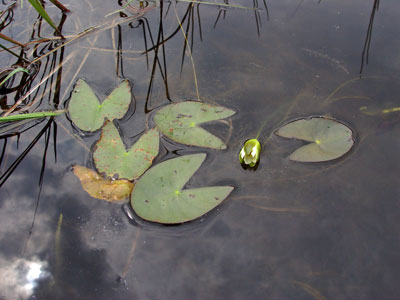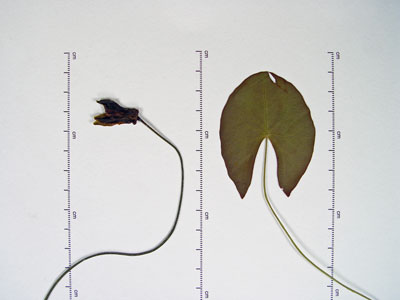DACF Home → Bureaus & Programs → Maine Natural Areas Program → Communities, Plants, and Animals → Rare Plants → Nymphaea leibergii

Nymphaea leibergii Morong
Pygmy Water-lily
- State Rank: S1S2
- Global Rank: G5
- State Status: Threatened
Habitat: Pond margins and swamps. [Open water (non-forested, wetland)]
Range: Quebec to British Columbia, south to northern Maine, northern Michigan, northern Minnesota, Idaho, Washington, also eastern Asia.
Aids to Identification: The pygmy water lily is a miniature version of its close relative, fragrant water lily (N. odorata) which is common in Maine. The pygmy water lily flowers are white, lined with crimson, and are only 4-8 cm across. The floating, deeply sinused leaves are about 4-9 cm wide and have distinctly forking rather than net-like veins.

Ecological characteristics: Nymphaea leibergii seems to prefer areas of shallow water (1-2 meters), mud bottom, little or no current, and pH near neutral. It is a perennial and can reproduce vegetatively by tuberous offshoots from its underground rhizome. Flowering is variable. At some locations, no flowers are evident; at others, flowering individuals dominate. Flowers reputedly open only in the afternoon.
Phenology: Flowers July - September.
Family: Nymphaeaceae
Synonyms: Castalia leibergii Morong; Nymphaea tetragona Georgi ssp. leibergii (Morong) Porsild; Nymphaea tetragona Georgi var. leibergii (Morong) Boivin.
Known Distribution in Maine: This rare plant has been documented from a total of 13 town(s) in the following county(ies): Aroostook, Piscataquis, Somerset.
Reason(s) for rarity: Southern range limit, habitat naturally scarce.
Conservation considerations: Unknown. Often occurs as small populations with unpredictable persistence.
For more information, see the Native Plant Trust's Conservation Plan for Nymphaea leibergii.